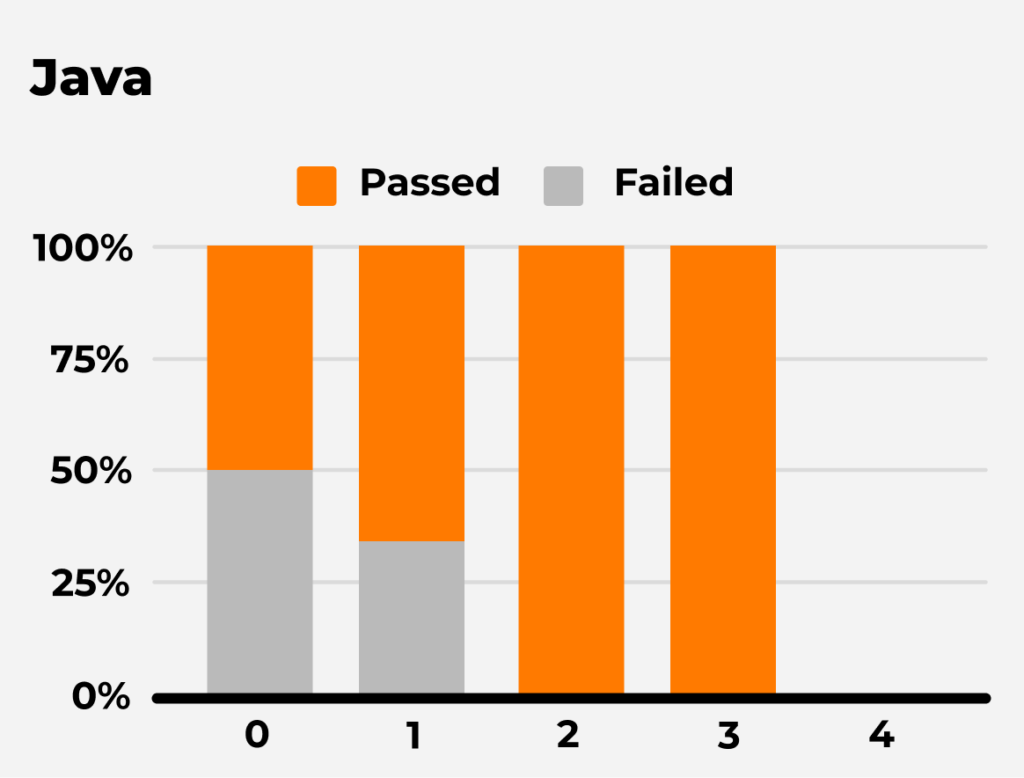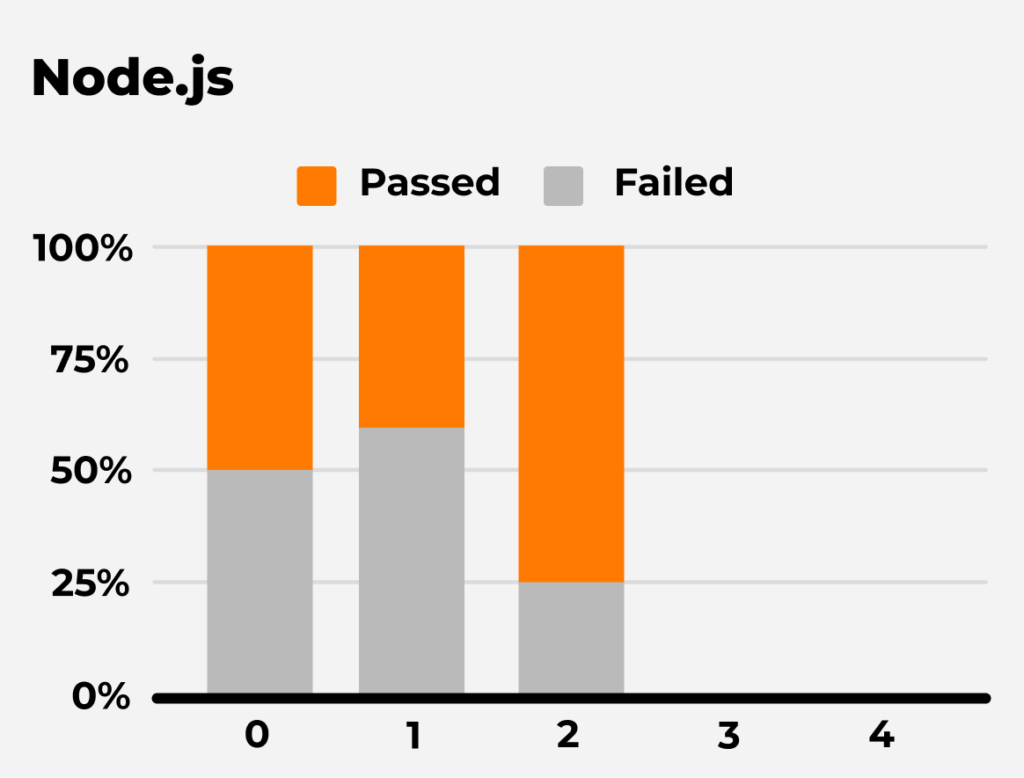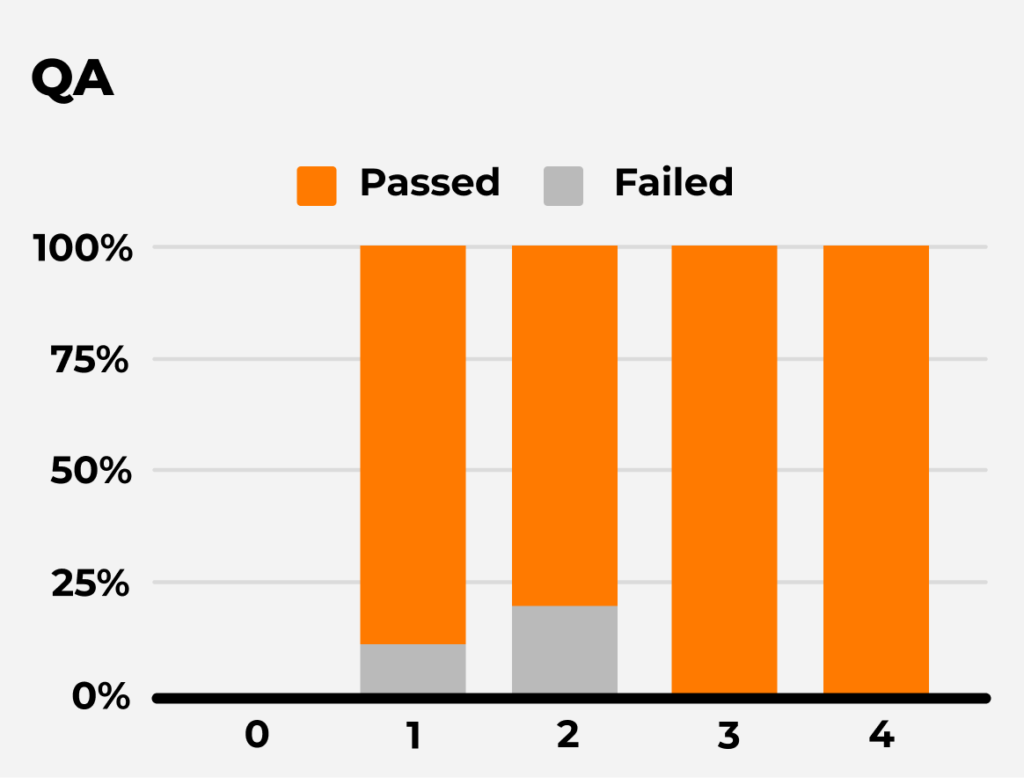
AgileEngine Blog > Insights > Why engineers need strong problem-solving skills—and how to ensure your team has them

Why engineers need strong problem-solving skills—and how to ensure your team has them

Table of Contents

Alex Gorlatov
A story about hiring the wrong person.
As a young engineer before joining AgileEngine, I had a co-worker. Let’s call him Dave.
I met Dave when the company interviewed him for a Java development job. His technical interview with us focused on simple, direct questions to assess his knowledge of specific backend technologies, like Java and SQL. He did well, showing strong knowledge of the programming side of backend web development. The company hired him.
But after he came on board, Dave struggled. His managers delegated new web application features for him to implement, expecting him to own the outcomes and deliver. But he often didn’t know where to start his work or how to break it down into manageable tasks for himself. For the work to get done, he needed his specific tasks defined for him. Though he knew the tech, he just couldn’t solve problems on his own.
In his defense, the requirements for these features were not always crystal clear. These vague inputs made Dave’s job harder. Nevertheless, the job description mentioned the need for a person to own such efforts — including elaborating requirements — and such was the company’s expectation.
After a year of low productivity, Dave left the company.
The problem: The gap between technical knowledge and solving unstructured problems
Technology organizations frequently face this challenge. Many engineers intimately know the details of their chosen technologies but fail to solve unstructured problems that cover unfamiliar territory. Such difficulties might involve a bleeding-edge technology, a company-wide business flow, or a novel challenge without an existing pattern to apply.
To overcome these or similar difficulties, engineering teams need broader creative skills to innovate and tackle new problems.
The solution: Building general problem-solving skills
In my experience, solving complex real-world software engineering problems requires an ability to:
- Define or clarify stakeholders’ desired outcomes
- Identify root causes of difficulties
- Decompose a challenge (or solution) into smaller pieces that are easier to solve (or manage)
- Ideate solutions, both alone and while collaborating with other team members
- Plan and conduct quality assurance
These skills are really about system design in general and do not belong to any single technical domain. Engineers with these broad skills can tackle just about any analytical or engineering difficulty as long as they also have the requisite (and complementary) technical knowledge.
One more observation: while some hard problem-solving skills (e.g., root cause analysis) can be taught via courses or books, the ability described here also depends on things like temperament and aptitude. As with computer programming, a person typically either has a knack for it or doesn’t. Thus, one of the best ways to develop this capacity in your organization is to screen for it when hiring.
Our approach: Evaluate candidates for broad problem-solving during interviews
In remote software engineering engagement models with higher degrees of autonomy and initiative, like dedicated teams or managed projects, problem-solving is critical for success. For this reason, our hiring process involves an evaluation of general problem-solving skills in addition to specific technical knowledge.
At AgileEngine, extensive screening for problem-solving skills is mandatory for senior, lead, or higher engineering positions. We also include it for any seniority level when selecting experts for a dedicated team with a demanding problem-solving culture and a high sense of product ownership.
To evaluate these skills during the candidate’s interview, we present them with an open-ended design challenge that roughly corresponds to their technical specialty. We give them a broad, slightly ambiguous technical problem and ask them to explain how they would go about solving it.
Naturally, we have different expectations for the different seniority levels. We give each candidate a score of 0 to 4 based on the following criteria.
Skills expectations for a junior engineer
- Understands basic requirements and has the ability to ask questions to clarify when needed.
Skills expectations for a middle engineer
- May suggest small or mid-size feature estimates.
- Knows how to split tasks, especially for their tech stack.
- Has analytical thinking skills, breaking down issues to identify causes.
- Can come up with ideas that can be used as a starting point when tackling complex tasks.
Skill expectations for a senior engineer
- Performs discovery for a feature, asking questions and collecting data.
- Organizes the feature breakdown and provides estimations for both backend and frontend.
- Understands what to do if there are no QA engineers on the team.
- Can come up with a strategy to locate the source of the difficulty and can also mention different strategies for solving it.
- Can analyze and discuss trade-offs for proposed solutions.
Skill expectations for a lead engineer
- Has solid experience driving the development of new products from scratch.
- Drives communication with the client to collect functional and non-functional requirements and knows how to initiate and conduct the necessary discovery activities.
- Organizes the feature breakdown and provides estimations.
- Has awareness of the team’s strengths and capabilities.
- Considers time for automated testing and cares about future maintainability and scalability.
- Can diagnose and solve complex problems and help others to solve them.
- Can propose innovative solutions to challenging problems often requiring optimization or efficiency improvements.
- Uses systematic problem-solving methodologies (e.g., root cause analysis, hypothesis testing).
Discover how our top 1% experts create products featured by Forbes, G2, and Facebook
Our results: correlation between general problem-solving excellence and passing our clients’ interview process.
Since implementing the evaluation in our interviews, we have seen a dramatic increase in client satisfaction with the team members we have brought forward into our engagements. Our candidates who receive top scores for general problem-solving are up to three times more likely to pass the full interview process than those with low scores. The precise difference depends on the technology stack.
Here are the metrics broken down by tech stack or specialization.

In the hiring process for Java engineering roles, AgileEngine’s candidates with higher general problem-solving scores (2 or 3) were twice as likely to be accepted by clients as those with low scores (0).

React.js candidates with higher general problem-solving scores (2, 3, or 4) were roughly three times more likely to be accepted by clients than those with low scores (0 or 1).

Node.js candidates with higher general problem-solving scores (2) were roughly twice as likely to be accepted by clients as those with low scores (0 or 1).

QA engineering candidates with higher general problem-solving scores (3 or 4) were roughly 33% more likely to be accepted by clients than those with low scores (0, 1, or 2).
The evidence above speaks to the significance that companies attach to problem-solving skills when engaging engineering talent. Engineering teams often have to deal with challenges characterized by unclear or changing scope and complexity that goes beyond technology. By prioritizing candidates with strong problem-solving skills, companies can tackle such challenges faster and gain an edge over the competition.
In today’s increasingly competitive and quickly evolving world, you need people who can find innovative solutions to non-trivial challenges. Specific technical skills are often not enough for this — you must find engineers who can analyze, define, and decompose problems that haven’t been solved before.
AgileEngine has vast expertise in ensuring that new members of our clients’ remote teams have this capability. Our approach to candidate selection empowers our clients to create innovative solutions that win awards, get top-rated by the Play Store and App Store, and land top spots on G2 and Gartner. Talk to our experts and explore what positive impact this approach can have on your digital product.
Engage top website and app accessibility engineers and designers
Alex is a technology executive with a 25-plus-year background as a development manager, scrum master, and software architect. specializing in business process automation, system integration, and custom solutions development, he empowers clients across industries to streamline operations, amplify communication, and optimize it investments for maximum impact., share this post, related articles.

Navigating the FTC’s “click-to-cancel” rule: how subscription-based companies can thrive with churn prediction

AI presents CTOs with new opportunities to impact UX. Here’s how to make the best use of them

One in two companies struggles with tech project delays and overspending. Here’s how dedicated teams fix this
Dedicated teams
We are social.

- What is Chemical and Biological Engineering?
- Engineering problem solving
- Error and uncertainty
- Process variables
- Process Fundamentals
- Material Balances
- Reacting systems
- Reaction kinetics
- Reactor design
- Bioreactors
- Fluids and fluid flow
- Mass transfer
- Energy balances
- Heat transfer
- Heat exchangers
- Mechanical energy balances
- Process safety
- Engineering ethics
- Sustainability
- Engineering in a global context
- How ‘good’ a solution do you need
- Steps in solving well-defined engineering process problems, including textbook problems
- « What is Chemi...
- Teamwork »
Engineering Problem Solving ¶
Some problems are so complex that you have to be highly intelligent and well-informed just to be undecided about them. —Laurence J. Peter

Steps in solving ‘real world’ engineering problems ¶
The following are the steps as enumerated in your textbook:
Collaboratively define the problem
List possible solutions
Evaluate and rank the possible solutions
Develop a detailed plan for the most attractive solution(s)
Re-evaluate the plan to check desirability
Implement the plan
Check the results
A critical part of the analysis process is the ‘last’ step: checking and verifying the results.
Depending on the circumstances, errors in an analysis, procedure, or implementation can have significant, adverse consequences (NASA Mars orbiter crash, Bhopal chemical leak tragedy, Hubble telescope vision issue, Y2K fiasco, BP oil rig blowout, …).
In a practical sense, these checks must be part of a comprehensive risk management strategy.
My experience with problem solving in industry was pretty close to this, though encumbered by numerous business practices (e.g., ‘go/no-go’ tollgates, complex approval processes and procedures).
In addition, solving problems in the ‘real world’ requires a multidisciplinary effort, involving people with various expertise: engineering, manufacturing, supply chain, legal, marketing, product service and warranty, …
Exercise: Problem solving
Step 3 above refers to ranking of alternatives.
Think of an existing product of interest.
What do you think was ranked highest when the product was developed?
Consider what would have happened if a different ranking was used. What would have changed about the product?
Brainstorm ideas with the students around you.
Defining problems collaboratively ¶
Especially in light of global engineering , we need to consider different perspectives as we define our problem. Let’s break the procedure down into steps:
Identify each perspective that is involved in the decision you face. Remember that problems often mean different things in different perspectives. Relevant differences might include national expectations, organizational positions, disciplines, career trajectories, etc. Consider using the mnemonic device “Location, Knowledge, and Desire.”
Location : Who is defining the problem? Where are they located or how are they positioned? How do they get in their positions? Do you know anything about the history of their positions, and what led to the particular configuration of positions you have today on the job? Where are the key boundaries among different types of groups, and where are the alliances?
Knowledge : What forms of knowledge do the representatives of each perspective have? How do they understand the problem at hand? What are their assumptions? From what sources did they gain their knowledge? How did their knowledge evolve?
Desire : What do the proponents of each perspective want? What are their objectives? How do these desires develop? Where are they trying to go? Learn what you can about the history of the issue at hand. Who might have gained or lost ground in previous encounters? How does each perspective view itself at present in relation to those it envisions as relevant to its future?
As formal problem definitions emerge, ask “Whose definition is this?” Remember that “defining the problem clearly” may very well assert one perspective at the expense of others. Once we think about problem solving in relation to people, we can begin to see that the very act of drawing a boundary around a problem has non-technical, or political dimensions, depending on who controls the definition, because someone gains a little power and someone loses a little power.
Map what alternative problem definitions mean to different participants. More than likely you will best understand problem definitions that fit your perspective. But ask “Does it fit other perspectives as well?” Look at those who hold Perspective A. Does your definition fit their location, their knowledge, and their desires? Now turn to those who hold Perspective B. Does your definition fit their location, knowledge, and desires? Completing this step is difficult because it requires stepping outside of one’s own perspective and attempting to understand the problem in terms of different perspectives.
To the extent you encounter disagreement or conclude that the achievement of it is insufficient, begin asking yourself the following: How might I adapt my problem definition to take account of other perspectives out there? Is there some way of accommodating myself to other perspectives rather than just demanding that the others simply recognize the inherent value and rationality of mine? Is there room for compromise among contrasting perspectives?
How ‘good’ a solution do you need ¶
There is also an important aspect of real-world problem solving that is rarely articulated and that is the idea that the ‘quality’ of the analysis and the resources expended should be dependent on the context.
This is difficult to assess without some experience in the particular environment.
How ‘Good’ a Solution Do You Need?
Some rough examples:
10 second answer (answering a question at a meeting in front of your manager or vice president)
10 minute answer (answering a quick question from a colleague)
10 hour answer (answering a request from an important customer)
10 day answer (assembling information as part of a trouble-shooting team)
10 month answer (putting together a comprehensive portfolio of information as part of the design for a new $200,000,000 chemical plant)
Steps in solving well-defined engineering process problems, including textbook problems ¶
Essential steps:
Carefully read the problem statement (perhaps repeatedly) until you understand exactly the scenario and what is being asked.
Translate elements of the word problem to symbols. Also, look for key words that may convey additional information, e.g., ‘steady state’, ‘constant density’, ‘isothermal’. Make note of this additional information on your work page.
Draw a diagram. This can generally be a simple block diagram showing all the input, output, and connecting streams.
Write all known quantities (flow rates, densities, etc.) from step 2 in the appropriate locations on, or near, the diagram. If symbols are used to designate known quantities, include those symbols.
Identify and assign symbols to all unknown quantities and write them in the appropriate locations on, or near, the diagram.
Construct the relevant equation(s). These could be material balances, energy balances, rate equations, etc.
Write down all equations in their general forms. Don’t simplify anything yet.
Discard terms that are equal to zero (or are assumed negligible) for your specific problem and write the simplified equations.
Replace remaining terms with more convenient forms (because of the given information or selected symbols).
Construct equations to express other known relationships between variables, e.g., relationships between stoichiometric coefficients, the sum of species mass fractions must be one.
Whenever possible, solve the equations for the unknown(s) algebraically .
Convert the units of your variables as needed to have a consistent set across your equations.
Substitute these values into the equation(s) from step 7 to get numerical results.
Check your answer.
Does it make sense?
Are the units of the answer correct?
Is the answer consistent with other information you have?
Exercise: Checking results
How do you know your answer is right and that your analysis is correct?
This may be relatively easy for a homework problem, but what about your analysis for an ill-defined ‘real-world’ problem?

The Problem Solving Steps all Engineers Should Know
Imagine walking into a room, everyone is clamoring for answers and after a few moments you know exactly what everyone should do to fix the problem.
You deal with problems on a daily basis as an Engineer but sometimes you run into the situation where you solve the wrong problem, or senior engineers get frustrated with how long it's taking to complete a task - perhaps they gave you some vague problem statement and when you asked for some direction it was still high level because it should be "obvious".
I think where people get caught is the Senior engineers giving out tasks aren't necessarily looking to walk you through a solution, they want a problem to go away, they want to spend as close to zero brain cells on the problem (at this point in time). So your job is to make it go away and not to use their brain cycles.
But this is counter intuitive, if I don't know where to start or I take too long then that will also be frustrating since the problem will still be there.
Correct. So you are caught in between a rock and a hard place. But it's not the worst and we can certainly equip ourselves with the skills we need to handle these situations.
What's the situation?
Problem Solving and reducing our "mean-time to solve". There's a spectrum of problems one can consider and if you realize this you can see that more complex problems do require more time to solve - there's an "expected" time to solve. So you want to perform in such a way that you are below this line as much as is practicable.

I've worked in Engineering for over a decade now and I can tell you that for sure there are specific tricks to solving particular problems specific to the industry, company, field, technology, etc. You gain these by purely time. Working on problems and solutions in that area. This is why experience is king - but it is also overrated sometimes.
Someone with 5 years more experience may not be very good and if you only looked at the number of years you would be none the wiser.
So how can we overcome this hurdle and forget the number of years we've worked and just perform better?
Use the book 10+1 Steps to Problem Solving: An Engineers Guide.
Here I created simple steps to follow that looks at a more birds-eye view but is so practical you can apply it to any situation.
But this isn't some "one-size fits all" methodology, nor is it "how do I calculate the potential energy in this craft", "how do you enable this features in this software". Don't get it twisted.
But it does help formalize your approach, use the right mindset and ask the right questions at the various stages of problem solving.
What's wrong with Steps to Problem Solving lists out there? They are mostly correct, but the primary issue is they are so generic and have little practicality. They lay out steps around identification of the problem, analysis, breaking it down to small bits, evaluating. But more often than not they spend half the time talking about implementation, working out the kinks, timing, etc.
This presents 2 problems:
It is super slow
It is solution focused
I'm not saying you shouldn't plan out your solutions and have implementation plans, timings, schedules, documentation - you need these (at the solution stage). But when you plan out how you are going to try to fix something and spend all this time pondering - you could have simply tried and moved on.
You either fixed it or you got more data.
You iterate faster through your questions, quick testing of the obvious things, getting eyes on the situation in the correct way, checking your fundamentals and proceeding from there. (These are still in the first three steps by the way).
The rest of the steps are still focused on going deeper into the rabbit hole to solve your problems. This is when you are stuck, for hours, days, weeks!
So what are the steps?
Here's direct extract of the index:
The Question
The Obvious
Check Yourself
The RTFM Protocol
What about the Environment?
Phone-A-Friend
The Secret Step
The book goes on to explain each of these steps and provide a checklist style summary at the end of each. You can practically use this as a framework to approach problems, particularly tricky ones so that you can reduce the average amount of time you spend fixing things. There's real examples from easy to difficult ones covered so you gain context on how to fix.
I really wanted to help as many people as I can with this so I actually made the book completely free. You can get online access and read the whole thing from my website here .
It will require you create an account but other than that you are good.
At the time of this writing only the first 2 chapters are available, but you are getting early access as the book isn't set to release until the 4th Quarter of this year! (In time for Christmas).
You can register to get notified when the release is coming out so you can be first in line to get your own copy.
What's the advantage of problem solving this way?
So if you remember to the opening of this article we did cover some of the pain points and frustrations that can happen in an engineering career. So think of it this way, if you can consistently solve problems and make things go away, or better yet, things seem to get fixed faster when you are around - then you'll be wanted around.
This tends to have a compounding effect where you help others solve their problems simply by understanding this method and asking the right questions to get them to their own answer, and now people want you on bigger projects.
You do this and gain more responsibility and then now you have the foundation for increasing your pay, your role and your impact. (There's challenges here of course but I will have courses and free content to address these). You can become one of the "go to" engineers in your company.
Every Engineer should be aware of these problem solving steps.
Get your free book access today.
- Technical Tactics
- Engineering Evolution
- Engineering Resource
Recent Posts
The Stress-Free Guide to Applying to College or Graduate School
How to Implement OSHA’s Requirement of Emergency Medical Services in Construction
Revolutionizing Transport: The 5 Key Areas Shaping the Future of ITS
Comentarios
Get your free Engineering Toolkit for Engineering IRL listeners only

Get a copy of the Operational Technology Ultimate Guide for Engineers e-book for free.
A Practical Guide to Problem-Solving Techniques in Systems Engineering
In the world of systems engineering, identifying and addressing issues is a significant part of the job. To ensure the smooth operation of complex systems, engineers employ various practical problem-solving techniques. Problem-solving techniques are not limited to solving issues specific to any one system, but can also be applied when generating new product ideas and solutions.
We'll start by exploring some common analytical and systematic problem-solving techniques, including thought experiments, the 5 Whys, and root cause analysis, before looking at some more creative techniques.
Analytical and Systematic Problem-Solving Techniques
Thought experiments.
A thought experiment is a disciplined imagination process that engineers use to ponder a problem or system without conducting physical experiments. By using hypothetical scenarios, engineers can predict potential challenges and find solutions without the cost and time of real-world testing.
For instance, consider the design of an urban traffic control system. Engineers can create a thought experiment about how the system would handle an emergency, such as a major traffic accident during rush hour. This mental exercise could help identify potential bottlenecks or gaps in the system, allowing engineers to design more effective controls or contingency plans.
The 5 Whys technique, originally developed by Toyota, is a simple yet effective method to drill down to the root of a problem. By repeatedly asking "why?" in response to the previous answer, engineers can uncover the underlying cause behind an issue.
Imagine a server crash in a data centre. The 5 Whys process might look like this:
- Why did the server crash? Because it overheated.
- Why did it overheat? Because the cooling system failed.
- Why did the cooling system fail? Because the coolant was not circulating.
- Why was the coolant not circulating? Because the pump was broken.
- Why was the pump broken? Because it was not maintained as per the recommended schedule.
Through this process, we learn that the root cause of the server crash was inadequate maintenance, not merely a random hardware failure.
Root Cause Analysis (RCA)
Root cause analysis (RCA) is a systematic process for identifying the underlying causes of faults or problems. RCA aims to prevent the same problems from recurring by eliminating the root cause rather than treating the symptoms.
For example, suppose a manufacturing assembly line is regularly shutting down due to equipment failure. Rather than just fixing or replacing the equipment each time, an RCA might uncover that a specific part is consistently under high stress due to improper alignment, causing it to fail. By correcting this alignment, the systems engineer can prevent the problem from recurring.
Fault Tree Analysis (FTA)
Fault Tree Analysis (FTA) is a top-down, deductive analysis method used to explore the many different causes of a specific failure or undesirable outcome. It graphically represents the logical relationships between subsystem failures, potential human errors, and external events in the form of a tree.
Suppose a software system suffers from frequent downtime. The FTA would start with the undesired event at the top (downtime), and then branch out into various potential causes such as software bugs, hardware failure, network issues, and so on. Each of these branches can then be subdivided further into more specific faults, allowing the engineer to understand all potential causes of the problem and prioritise the most likely or serious ones for remediation.
Simulation Modelling
Simulation modelling is a powerful tool that allows systems engineers to predict the behaviour of a system under different conditions. By creating a digital twin of a real-world system, engineers can understand the system's response to changes in variables, identify potential issues, and test solutions.
For instance, in a complex logistics operation, a simulation model can be used to understand the impact of adding a new product line or increasing order volume. This could reveal potential bottlenecks or inefficiencies, allowing proactive adjustments to be made before they become real-world problems.
Creative Problem-Solving Techniques
Beyond the analytical and systematic problem-solving techniques traditionally used in engineering, there are numerous creative methods that can be applied. These techniques stimulate lateral thinking, enabling you to view problems from a fresh perspective and identify innovative solutions. Here are a few examples:
Brainstorming
Brainstorming is perhaps one of the most commonly used creative problem-solving techniques. It involves gathering a group of people and encouraging them to freely share their thoughts and ideas related to a specific problem. The key is to refrain from any judgment or criticism during the brainstorming process to encourage free thought and out-of-the-box ideas.
SCAMPER is a creative-thinking technique that uses seven types of transformations: Substitute, Combine, Adapt, Modify, Put to another use, Eliminate, and Reverse. By examining a problem through these different lenses, you can generate novel solutions. For example, if you're trying to enhance the efficiency of a manufacturing process, you might "Adapt" a method from a completely different industry or "Combine" two existing processes into one.
Mind Mapping
Mind Mapping is a visual tool that helps structure information, enabling you to better analyse, comprehend, and generate new ideas. Starting with a central concept, you add nodes branching out into related subtopics. This can reveal unexpected connections and encourage creative problem-solving.
Six Thinking Hats
This technique, devised by Edward de Bono, involves viewing a problem from six distinct perspectives, symbolised by hats of different colours. The white hat considers facts and information, the red hat looks at the issue emotionally, the black hat uses caution and considers risks, the yellow hat optimistically thinks about benefits, the green hat encourages creativity, and the blue hat manages the process and oversees the big picture.
Analogy Thinking
Analogy thinking, or analogous thinking, is a method of comparing the problem at hand to other similar situations or phenomena. By drawing parallels, you might find creative solutions that you would not have considered otherwise. For example, an engineer might draw inspiration from the natural world, such as how a bird flies or a tree distributes nutrients, to solve a complex mechanical or systems problem.
In conclusion, problem-solving in systems engineering represents a harmonious blend of art and science. It's not about completely discarding systematic, logical techniques, but instead complementing them with creative strategies. This combination of traditional and creative methods equips systems engineers with the tools to predict, identify, and address issues effectively and efficiently. By fostering a balance between analytical and innovative thinking, fresh insights can be gained and novel solutions developed. This fusion is often where the most impactful solutions are found. As these techniques are regularly practiced and mastered, they can lead to smoother operations, reduced downtime, and ultimately more successful projects. The artistry lies in the creativity, and the science in the application and understanding of these tools, culminating in an exciting, evolving, and rewarding field.
This content was generated using OpenAI's GPT Large Language Model (with some human curation!). Check out the post "Explain it like I'm 5: What is ChatGPT?" to learn more.
The Power of Active Inference in Systems Engineering
Applications of the pyramid principle in systems engineering, you might also like..., stock and flow modelling, the art of debugging, the importance of model testing and types, building simulations that scale.

IMAGES
VIDEO
COMMENTS
The 10 steps to problem solving like an Engineer. Who can advise on the best approach to problem solving other than the professional problem solvers - Yes. I'm talking about being an Engineer. There are 2 main trains of thought with Engineering
In this article, we explore the essence of engineering problem-solving, its key methodologies, and its significance in real-world applications.
Every engineer is hired, retained, and rewarded for his or her ability to solve problems. However, engineering graduates are ill prepared to solve complex, workplace problems (Jonassen, Strobel, & Lee, 2006). Problem solving from a cognitive perspective has been the primary focus of my research for the past decade and a half.
Problem solving is the process of determining the best possible action to take in a given situation. The nature of problems that engineers must solve varies between and among the various branches of engineering. Because of the diversity of problems there is no universal list of procedures that will fit every problem. Not every engineer uses the ...
QA engineering candidates with higher general problem-solving scores (3 or 4) were roughly 33% more likely to be accepted by clients than those with low scores (0, 1, or 2). The evidence above speaks to the significance that companies attach to problem-solving skills when engaging engineering talent.
However, with a step-by-step approach and some practical strategies, you can simplify the process and tackle even the most complicated problems. In this blog, we'll break down the art of problem-solving in engineering. • STEP 1: DEFINE THE PROBLEM. The initial and crucial step in solving any engineering problem is to define it clearly.
Another view of engineering modeling 1. Clearly define the problem. a. What do you want to know? b. Identify your system or CV. 2. Model the problem. a. What physics are important for the given system and process, e.g., what governing equations are relevant? b. Identify the significant mass, energy, and force interactions with the surroundings. c.
Steps in solving 'real world' engineering problems¶ The following are the steps as enumerated in your textbook: Collaboratively define the problem. List possible solutions. Evaluate and rank the possible solutions. Develop a detailed plan for the most attractive solution(s) Re-evaluate the plan to check desirability. Implement the plan ...
The problem solving steps to fix things faster and get you on bigger projects. These are problem skills all engineers should know. 10+1 Steps to Problem Solving: An Engineers Guide will lay out the steps for you. The problem solving steps all engineers should know to elevate their career and fix things faster. top of page.
In the world of systems engineering, identifying and addressing issues is a significant part of the job. To ensure the smooth operation of complex systems, engineers employ various practical problem-solving techniques. Problem-solving techniques are not limited to solving issues specific to any one system, but can also be applied when